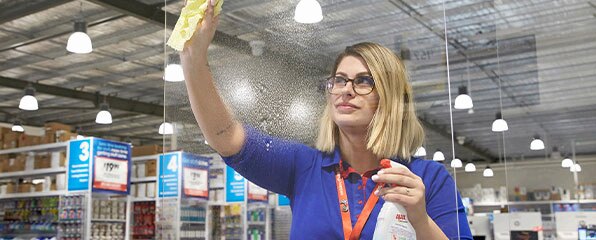
Commitment 18: Phase out problematic plastics
What’s the issue?
In many products, plastic is a useful material as it is low cost and long lasting. However, some types of plastic present significant problems to the environment as they are unable to be recycled and may never break down, contributing to environmental issues on land and in our waterways.
What are we doing?
We’ve defined problematic plastics in the broadest sense to include to include plastic that is difficult to recycle or causes significant environmental issues (such as PVC, expanded polystyrene or micro-plastics), single use plastic, (such as items to be designed or intended to be discarded after a single use, such as plastic cutlery), or plastic that is deemed as unnecessary (which is particularly apparent in secondary packaging materials).
Using this definition, we have developed a strategic approach to address problematic plastics of most concern. Our key achievements during the year include;
- Phasing out polystyrene from all own-brand furniture and technology items
- Removing PVC from all own-brand packaging
- Removing glitter from our own-brand kids art and craft range, and introducing plastic-free glitter alternatives
- Began phasing out single use catering supplies, such as plastic plates, bowls and cutlery
- Removed the annual equivalent of 6.7 million pieces of unnecessary plastic packaging
Focus for FY2022
From July 2021, we will stop selling single use plastic products such as cutlery and plates and provide our customers with sustainable and affordable alternatives. By doing this, more than 32 million pieces of plastic will be avoided each year, which is around 200,000 kgs plastic. We will conduct further assessments to identify our next opportunities to remove problematic plastics and implement solutions to address these. We will continue to work collaboratively with our suppliers and the industry more broadly to help accelerate progress being made.
Learn more about another 2025 commitment
Our Team
Our Community
Human Rights
Climate Action
Circular Economy
How are we going so far? Find out in our 2019-2020 report.
Information
- About Us
- Policies
- Social Media House Rules
- Price Beat Guarantee
- Payment Options
- Express Pay
- Afterpay
- Zip
- Flybuys
- Optus Bundle Bonus FAQs
- Quality Print Promise
- Our delivery options
- Return Policy
- Product Recalls
- Terms of Use
- PCI FAQs
- Privacy Policy
- Scam Warnings
- Whistleblower Policy
- Gift Card Policy
- Rate & Win Competition Terms & Conditions
- OnePass
- CES Prize Draw TCs
- Payment Options
- Officeworks App
- Track your order
- Click & Collect
- Cost per page
- 3D Secure
- Customer Communications
- Talking point


 has the facebook
has the facebook




















